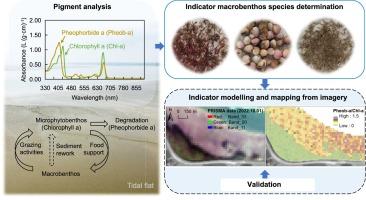Hyperspectral remote sensing of chlorophyll a and pheophorbide a pigments for macrobenthos mapping on an estuarine tidal flat
IF 7
2区 环境科学与生态学
Q1 ENVIRONMENTAL SCIENCES
引用次数: 0
Abstract
Macrobenthos play critical roles in estuarine tidal flats through bioturbation, biodeposition, and bioirrigation and serve as key elements in the food web, depending largely on microphytobenthos (MPB) and serving as prey for birds. As traditional field-based methods for determining the spatial distribution of macrobenthos are costly and time-consuming, in this study we investigated the potential of inferring macrobenthos from degradation products of chlorophyll-a, a proxy for MPB biomass. First, we identified the macrobenthic groups most closely related to the pheophorbide-a and chlorophyll-a (Pheob-a/Chl-a) ratios via in situ data, although relationships were typically not significant. We then characterized the spectral characteristics of this ratio through controlled indoor experiments, integrated them into a hyperspectral algorithm, and mapped the spatial distribution of macrobenthos in the Western Scheldt estuary with this algorithm via PRecursore IperSpettrale della Missione Applicativa (PRISMA) hyperspectral satellite data. Specifically, the ratio was significantly (but weakly) related to the macrobenthic group of carnivorous/omnivorous/scavenger-feeding Malacostraca and bivalves and subsurface deposit-feeding Gastropoda, as verified by independent data, without showing significant relationships with many other groups. The blue spectrum was sensitive to Pheob-a/Chl-a, and a stacking model leveraging this spectrum was used to estimate the ratio. The results indicated substantial spatial heterogeneity in the estimated Pheob-a/Chl-a from the PRISMA images. The spatiotemporal relationships between these macrobenthic groups and MPB varied. Thus, while the method is not suited for macrobenthos mapping, our proposed approach paves the way for further research using hyperspectral imagery for ecological assessment, with its potential and limitations discussed.

利用高光谱遥感叶绿素 a 和嗜磷酸盐 a 色素绘制河口滩涂大型底栖生物分布图
大型底栖生物通过生物扰动、生物沉积和生物灌溉在河口滩涂中发挥着关键作用,同时也是食物网中的关键要素,主要依赖于微囊藻(MPB)并成为鸟类的猎物。由于确定大型底栖生物空间分布的传统野外方法既费钱又费时,在本研究中,我们研究了从叶绿素-a(MPB 生物量的替代物)的降解产物推断大型底栖生物的可能性。首先,我们通过现场数据确定了与叶绿素-a(Pheob-a/Chl-a)比率关系最密切的大型底栖生物群,尽管两者之间的关系通常并不显著。然后,我们通过室内对照实验确定了这一比率的光谱特征,将其整合到高光谱算法中,并利用该算法通过 PRecursore IperSpettrale della Missione Applicativa (PRISMA) 高光谱卫星数据绘制了西斯海尔德河口大型底栖生物的空间分布图。具体而言,经独立数据验证,该比率与大型底栖生物中的肉食/食肉/食腐类 Malacostraca 和双壳类以及以地下沉积物为食的腹足类有明显关系(但很弱),而与许多其他类群没有明显关系。蓝色光谱对 Pheob-a/Chl-a 敏感,利用该光谱的叠加模型来估算比率。结果表明,PRISMA 图像估算出的 Pheob-a/Chl-a 在空间上存在很大差异。这些大型底栖生物群与 MPB 之间的时空关系也各不相同。因此,虽然该方法不适合大型底栖生物绘图,但我们提出的方法为利用高光谱图像进行生态评估的进一步研究铺平了道路,并讨论了其潜力和局限性。
本文章由计算机程序翻译,如有差异,请以英文原文为准。
求助全文
约1分钟内获得全文
求助全文
来源期刊

Ecological Indicators
环境科学-环境科学
CiteScore
11.80
自引率
8.70%
发文量
1163
审稿时长
78 days
期刊介绍:
The ultimate aim of Ecological Indicators is to integrate the monitoring and assessment of ecological and environmental indicators with management practices. The journal provides a forum for the discussion of the applied scientific development and review of traditional indicator approaches as well as for theoretical, modelling and quantitative applications such as index development. Research into the following areas will be published.
• All aspects of ecological and environmental indicators and indices.
• New indicators, and new approaches and methods for indicator development, testing and use.
• Development and modelling of indices, e.g. application of indicator suites across multiple scales and resources.
• Analysis and research of resource, system- and scale-specific indicators.
• Methods for integration of social and other valuation metrics for the production of scientifically rigorous and politically-relevant assessments using indicator-based monitoring and assessment programs.
• How research indicators can be transformed into direct application for management purposes.
• Broader assessment objectives and methods, e.g. biodiversity, biological integrity, and sustainability, through the use of indicators.
• Resource-specific indicators such as landscape, agroecosystems, forests, wetlands, etc.
 求助内容:
求助内容: 应助结果提醒方式:
应助结果提醒方式:


